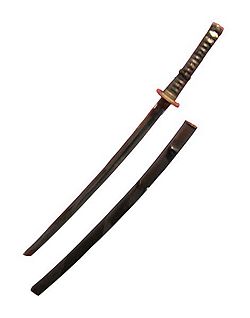Katana
 From Conservapedia - Reading time: 1 min
From Conservapedia - Reading time: 1 min
A katana (刀) is a two handed Japanese saber with a single edge. Although the term is generally applied to any Japanese sword, this is incorrect. For example, the tachi (太刀) sword was longer and more curved than a katana. The katana replaced the tachi as the weapon of choice, as it could be worn blade-up, thus enabling the wearer to draw and cut in one move.
A samurai warrior would usually carry a katana (or other long sword daito) into battle, along with a short sword (either a wakizashi (脇差) meaning "side arm" or a tantō (短刀) meaning "short sword"). Worn together, the pair of swords are called daishō, which literally means "large and small".
The blades are classified according to their length. A daito (long sword), for example a katana or tachi, would be over two shaku (where one shaku is equal to approximately 12 inches or 30 centimetres) in length. A shoto or wakizashi would be between one and two shaku long. A tantō blade would normally be less than one shaku in length. The length of a sword blade is measured from the pointed tip of the blade, to the notch just in front of the handle or grip.
The katana was considered to be a spiritual object for a samurai, who often named their swords, and it was rumoured their soul was in that blade. After the beginning of the Tokugawa Shogunate, only samurai were permitted to carry these swords.
 KSF
KSF